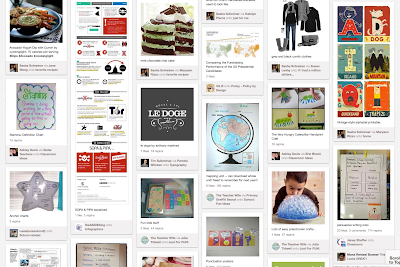In a matter of months, Pinterest has carved out a unique social space among the networks of status updates and limited characters. Now the fastest growing new medium,
Pinterest began two years ago but only recently saw its
visitors increase from 418,000 in May 2011 to 7.5 million by December.
Pinterest combines the best of social sharing and individual creativity. Users collect visuals from around the web and create virtual pinboards to organize ideas or share clippings. Educators are uniquely poised to tap into this tidy, engrossing, graphic scrapbook.
Here is our collection of
Pinterest boards, if you want to take a look:
pinterest.com/theasideblog.
Many analysts have tried to “pin” down the reasons for this bloom, even dwelling on an irrelevant gender-typing of Pinterest as “
shopping for women.” If the data shows that
men are catching up in their usage, it only validates the fact that Pinterest
now provides more traffic referrals than YouTube, Google+, Reddit, and LinkedIn combined. One Alaskan handywoman, for example, enjoys
over three million monthly visitors to her blog and
6,000 daily views via Pinterest linkage.
The number of educational pages, however, still lags the Pinterest mainstream. In theory, teachers should be prime candidates to benefit from Pinterest’s features and followers. The
visual nature and the easy partnering of ideas make it an optimal site for students to expand their horizons. Here are five reasons to become
a Pinteresting teacher:
1. Pinterest is the epitome of personal curation. It offers easy-access bookmarking, like
Diigo or
StumbleUpon, but in an efficient, visual layout. Teachers can catalog images to use in class or gather ideas for bulletin board displays. They can preserve the best of their browsing or design a portfolio of their favorite pages. Pinterest quickly gathers
graphics for lessons or ideas to revisit later.
2. Pinterest is ideal to use with students. It reinforces the
visual learning modality, particularly in an age when most children gain data through optical inputs. Pinterest equals note-taking for a generation of visual pupils. Instead of copying research facts in a traditional fashion, learners can collate details into a digital journal. Pinterest also teaches essential,
higher-level skills. It emphasizes symbolism and metaphor by ascribing definitional value to a set of collated images. It utilizes context as the clue to larger significance.
3. Pinterest prods students to pay attention. It echoes the advice of marketing consultant
Andy Stefanovich, who urges innovators to “
Look at More Stuff; Think About It Harder (LAMSTAIH).” Pinterest culls attention-grabbing images to enliven a page or post. The optics can encapsulate a message that a stream of text can often obscure. Pinboards virtually spark the imagination like the inspiration walls that designers and decorators have been using for years.
4. Pinterest’s array allows for broad visual scanning. By arranging images in a scrolling digest, students’ eyes and minds can take in large
fields of information.
Edward Tufte claims that displays are too often simplified for linear PowerPoint presentations and gratuitous white space. Pinterest gives credit to
the proficiency of the user, who can enjoy its range of clever and quirky images. Students’ brains absorb subtlety and appreciate the connections made through juxtaposed images. As a teaching tool initiated by the student herself, a pinboard offers more texture of sense than a single image can yield. It affords a coalescence of meaning through spatial adjacency.
5. Finally, Pinterest is social networking at its best. Friends become recommenders. Followings offer suggestions, rather than self-indulgent updates. Most pinners grab what surprises them, so a student can witness a litany of unexpected visual delights based on self-identified categories. Also, as with
Twitter, users have an incentive to populate their boards, to satisfy the curiosity of their followers and validate those fans’ faiths in their expertise. In this sense, Pinterest nudges out
Instagram, which relies on charming snapshots but a one-way mode of delivery. In browsing boards and media, students and teachers may realize the dream of the strolling
cyberflâneur.
Here is a good list from
The Teacher's Lane of teachers currently featured on
Pinterest.































